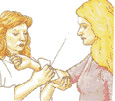Bleeding is the most visible result of an injury. Each
of us has between five and six quarts of blood in our
body. Most people can lose a small amount of blood with
no problem, but if a quart or more is quickly lost, it
could lead to shock and/or death.
|
 |
|
| |
| One of the best ways to treat bleeding is to place
a clean cloth on the wound and apply pressure with the palm
of your hand until the bleeding stops. You should also elevate
the wound above the victim's heart, if possible, to slow down
the bleeding at the wound site. |
| |
| Once the bleeding stops, do not try to remove the cloth that
is against the open wound as it could disturb the blood clotting
and restart the bleeding. If the bleeding is very serious, apply
pressure to the nearest major pressure point, located either
on the inside of the upper arm between the shoulder and elbow,
or in the groin area where the leg joins the body. |
 |
| |
| Direct pressure is better than a pressure point
or a tourniquet because direct pressure stops blood circulation
only at the wound. Only use the pressure points if elevation
and direct pressure haven't controlled the bleeding. Never use
a tourniquet (a device, such as a bandage twisted tight with
a stick, to control the flow of blood) except in response to
an extreme emergency, such as a severed arm or leg. Tourniquets
can damage nerves and blood vessels and can cause the victim
to lose an arm or leg. |
| |
|
|
|
| Insight
from Dr | Health News
| Health & Diseases
|
| Healthy Family
| Dr & Hospital | LifeTech
Health Series
| Contact |
Information on this site is provided for informational purposes and is
not meant to substitute for the advice provided by your own physician
or other medical professional.
If you have or suspect that you have a medical problem, promptly contact
your health care provider.
Information and statements regarding dietary supplements are not intended
to diagnose, treat, cure, or prevent any disease.
Copyright ©2001 LifeTech (Asia) Ltd.
|
 |MainPage | Company
Background |
|MainPage | Company
Background |
